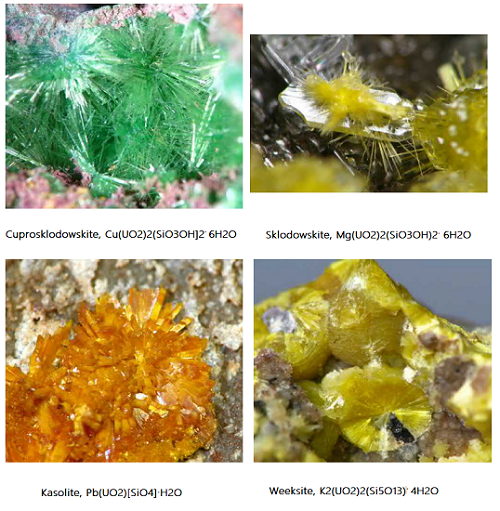Uranium: Chemical property and Minerals
May 31,2024
Introduction
Uranium is the 51st element in order of abundance in the Earth's crust. Uranium is also the highest-numbered element found naturally in significant quantities on Earth and is almost always combined with other elements. The decay of uranium, thorium, and potassium-40 in the Earth's mantle is believed to be the principal heat source that keeps the outer core liquid and drives mantle convection, which subsequently drives plate tectonics of the Earth's crust. Uranium's average concentration in the Earth's crust is between 2 and 4 ppm.
Chemical property
After refining, uranium is a silvery-white, weakly radioactive metal. It has a Mohs hardness of 6, about the same as that of titanium, rhodium, manganese and niobium. It is malleable, ductile, slightly paramagnetic, strongly electropositive and a poor electrical conductor. Uranium metal has an extremely high density of 19.1 g/cm3, denser than lead (11.3 g/cm3 ) but slightly less dense than tungsten and gold (19.3 g/cm3 ). Uranium metal has three allotropic forms: α stable up to 668 ℃ (orthorhombic, space group Cmcm, lattice parameters a 5 285.4 pm, b 5 587 pm, c 5 495.5 pm), β stable from 668 ℃ to 775 ℃(tetragonal, space group P42/mnm, P42nm, or P4n2, lattice parameters a 5 565.6 pm, b 5 c 5 1075.9 pm), and γ from 775 ℃ to the melting point—this is the most malleable and ductile state (body-centered cubic, lattice parameter a 5 352.4 pm).
Minerals

Uranium is found in hundreds of minerals, including uraninite (UO2, the most common uranium ore), carnotite (K2(UO2)2(VO4)2·3H2O), autunite (Ca(UO2)2(PO4)2·11H2O), uranophane (Ca(UO2)2(SiO3OH)2·5H2O), torbernite (Cu(UO2)2(PO4)2·10H2O), and coffinite (U(SiO4)·nH2O). Significant concentrations of uranium occur in some deposits, such as phosphate rock deposits, and lignite (often referred to as brown coal, is a soft, brown, combustible, sedimentary rock formed from naturally compressed peat. It is considered the lowest rank of coal due to its relatively low heat content.), and monazite ((Ce, La, Nd, Th)PO4) sands in uranium-rich ores (it is recovered commercially from deposits with as low as 0.1% uranium).
Uranium can be found in over 200, often very colourful minerals. About 85 of these minerals are found in the oxide class, for example, carnotite (K2(UO2)2(VO4)2·3H2O), curite (Pb3(UO2)8O8(OH)6·3H2O), francevillite (Ba(UO2)2(VO4)2·5H2O), schoepite ((UO2)8O2(OH)12·10H2O), tyuyamunite (Ca(UO2)2(VO4)2·5-8H2O), and uraninite (UO2).
The carbonates are represented by about 35 different minerals, such as andersonite (Na2Ca(UO2)(CO3)3·6H2O), liebigite (Ca2(UO2)(CO3)3·11H2O), rutherfordine ((UO2)CO3), and zellerite (Ca(UO2)(CO3)2·5H2O).
Within the sulfate class, 22 different minerals can be found that contain U, for example, cousinite (MgU2Mo2O11·6H2O), uranopilite, and zippeite (K3(UO2)4(SO4)2O3(OH)·3H2O).
About 75 different minerals are found in the phosphate class, for example, althupite (AlTh(UO2)7(PO4)4(OH)5O2·15H2O), autunite (Ca(UO2)2(PO4)2·11H2O), francevillite (Ba(UO2)2(VO4)2·5H2O), phurcalite, torbernite, tyuyamunite, ulrichite, and zeunerite.
The silicate class contains about 20 minerals with structural U, such as boltwoodite, cuprosklodowskite, kasolite, sklodowskite, uranophane, and weeksite.
- Related articles
- Related Qustion
- Is one gram of uranium really equivalent to 20 billion calories? Feb 28, 2024
The assertion that a gram of uranium yields 20 billion calories is a common misconception that requires clarification.
Supplementation with pyridoxal 5'-phosphate monohydrate can synthesize neurotransmitters such as dopamine and serotonin, maintaining a healthy nervous system.....
Nov 4,2025Biochemical EngineeringCesium is a relatively rare element, about 3 ppm in the Earth’s crust. It is the 45th most abundant element and the 36th among the metals. It is 3.3% as abundant as Rb, with which it is closely associated, chemically.....
May 31,2024Inorganic chemistryURANIUM
7440-61-1You may like






